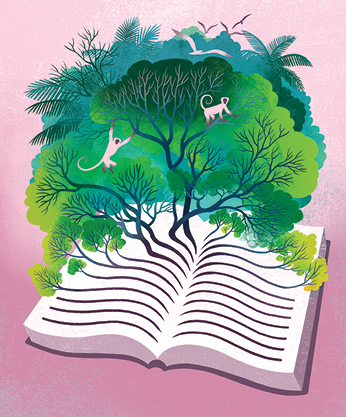Here we share our teaching ideas for four short stories you could use as starting points for addressing climate change. These four stories are all examples of climate fiction, “cli-fi” as it is popularly known, and come from two excellent collections: I’m with the Bears: Short Stories from a Damaged Planet and Winds of Change: Short Stories about Our Climate.*
The 12-page short story “How Close to the Savage Soul” in Winds of Change by environmental writer John Atcheson depicts a frightening near future altered by climate change. A grandfather, a young father in our present day, takes his grandson from the fortified community where they live to an Atlantic Ocean beach that had been beautiful and restorative. However, the water has risen and become acidic, increasing temperatures have devastated agriculture, and, outside their protected community, “adolescents without hope were turning the whole country into a real-world Lord of the Flies.”
If “How Close to the Savage Soul” is intense and frightening, a climate change short story that uses humor to make a serious point is “Hermie” by Nathaniel Rich in I’m with the Bears. This nine-page magical realist story works well with any grade level, from upper elementary through high school. The premise is that a marine biologist is about to give a lecture at an international conference when, in the hotel bathroom, he somehow encounters Hermie, the very hermit crab that he used to play with at a Florida beach when he was a boy. Of course Hermie can talk, and he reminds the narrator of the times they had together in childhood and informs him about how the beach and sea life have been devastated by rising sea levels, poisoned water, and worsening storms, resulting in loss of species.
The story personalizes the impacts of environmental degradation and provides an entry point for learning about global warming. It can also serve as a mentor text for place-based creative writing: students could write about either real or imaginary interactions with a place or wildlife that they knew as children, and then, in a realistic or perhaps magical realistic way as inspired by the story, project into the future and explore possible impacts of climate change.
A third story, “The Audit,” by Rachel May in Winds of Change, is also set in the near future. International agreements mandate “audits” to reduce everyone’s “climate footprint.” The story focuses on an upper-middle-class American family with three teenage children living in the suburbs. Their audit informs them:
“Your carbon footprint is 3.4 times the acceptable global mean. If everyone generated your level of greenhouse gases, 3.4 planet Earths would be required to accommodate the emissions. The terms of the Global Climate Accord require that you reduce your footprint as follows...”
“The Audit” is a perfect impetus for students to examine ways to learn about their own carbon footprint. There are several websites where students can have their carbon footprint calculated. Thus, the story is a starting point to research the “carbon budget” that scientists tell us must be adhered to in order to avoid the worst impacts of climate change. The story also shows students methods for addressing climate change in their lives. It opens discussion about how to make values-based choices, and creates opportunities for both self-reflective writing and writing to influence others.
Margaret Atwood’s two-page “Time Capsule Found on the Dead Planet” in I’m with the Bears is climate change flash fiction. Found in a cylinder of brass on a dry lake shore by travelers from a distant world, the time capsule tells of a civilization that worshiped money and created feasts and famine, towers of glass, and “ate whole forests, croplands, and the lives of children.”
The story presents a disturbing vision of where our planet might be if climate change is not addressed. It considers the natural environment in the long view, and invites young people to think about behavior and values from a climate change perspective. The story inspires discussion for additional learning about climate change, as well as serving as an inspiration for your students writing their own climate change flash fiction!
Richard Beach (link is external) is a professor emeritus of English education at the University of Minnesota, Twin Cities. Jeff Share (link is external) is a teacher education faculty adviser at the University of California, Los Angeles. Allen Webb (link is external) is a professor of English education and environmental studies at Western Michigan University.
*The stories from Winds of Change are available for free at www.dragonfly.eco/how-close-to-savage-the-soul. For a 30 percent discount on I’m with the Bears, from Verso Books, go to www.tinyurl.com/Y4QZE7R5. (back to article)


